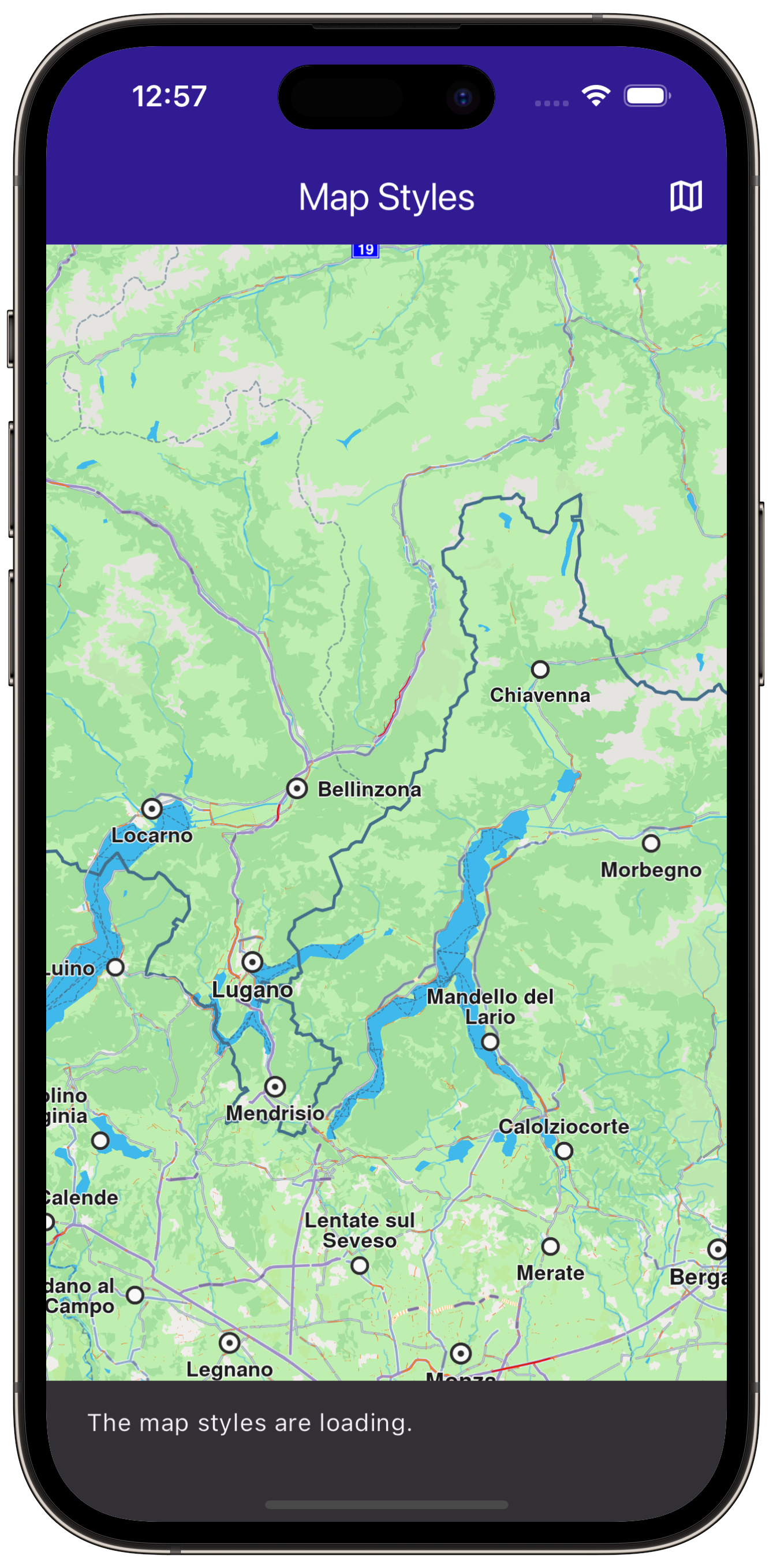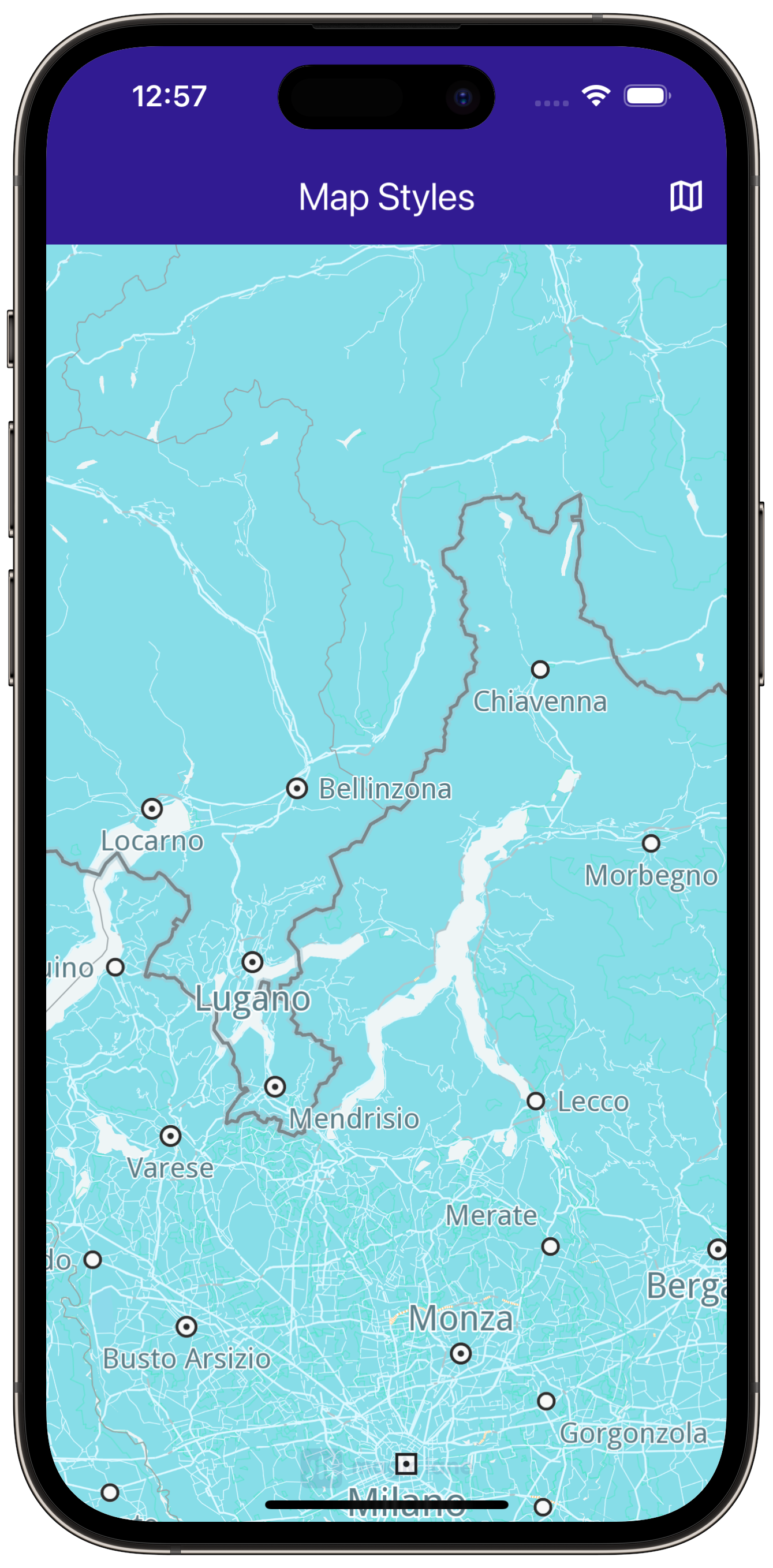Map Styles¶
|
|||
Setup¶
Prerequisites¶
Build and run¶
Go to the map_styles directory within the Flutter examples directory. This is the name of the example project.
Note - the gem_kit directory containing the Maps SDK for Flutter
should be in the plugins directory of the example, e.g.
example_pathname/plugins/gem_kit - see the environment setup guide above.
Run: flutter pub get
Configure the native parts:
First, verify that the ANDROID_SDK_ROOT environment variable
is set to the root path of your android SDK.
In android/build.gradle add the maven block as shown,
within the allprojects block, for both debug and release builds:
allprojects {
repositories {
google()
mavenCentral()
maven {
url "${rootDir}/../plugins/gem_kit/android/build"
}
}
}
in android/app/build.gradle
within the android block, in the defaultConfig block,
the android SDK version minSdk must be set as shown below.
Additionally, for release builds, in android/app/build.gradle,
within the android block, add the buildTypes block as shown:
Replace example_pathname with the actual project pathname
android {
defaultConfig {
applicationId "com.magiclane.gem_kit.examples.example_pathname"
minSdk 21
targetSdk flutter.targetSdk
versionCode flutterVersionCode.toInteger()
versionName flutterVersionName
}
buildTypes {
release {
minifyEnabled false
shrinkResources false
// TODO: Add your own signing config for the release build.
// Signing with the debug keys for now, so `flutter run --release` works.
signingConfig signingConfigs.debug
}
}
}
Then run the project:
flutter run --debugorflutter run --release
App entry and initialization¶
const projectApiToken = String.fromEnvironment('GEM_TOKEN');
void main() {
runApp(const MyApp());
}
This code initializes the projectApiToken with the required authorization token and launches the app.
How it works¶
This example demonstrates the following features:
Display and manage various map styles dynamically.
Provide smooth transitions between styles while ensuring a seamless user experience.
|
|||
Build the main application¶
Define the main application widget, MyApp.
class MyApp extends StatelessWidget {
const MyApp({super.key});
@override
Widget build(BuildContext context) {
return const MaterialApp(
debugShowCheckedModeBanner: false,
title: 'Map Styles',
home: MyHomePage(),
);
}
}
Handle map styles in the stateful widget¶
Create the stateful widget, MyHomePage, which will handle map styles.
|
|||
class MyHomePage extends StatefulWidget {
const MyHomePage({super.key});
@override
State<MyHomePage> createState() => _MyHomePageState();
}
Define state variables and methods¶
Within _MyHomePageState, define the necessary state variables and methods to interact with the map and manage styles.
class _MyHomePageState extends State<MyHomePage> {
late GemMapController _mapController;
final _stylesList = <ContentStoreItem>[];
int _indexOfCurrentStyle = 0;
bool _isDownloadingStyle = false;
@override
void dispose() {
GemKit.release();
super.dispose();
}
@override
Widget build(BuildContext context) {
return Scaffold(
appBar: AppBar(
backgroundColor: Colors.deepPurple[900],
title: const Text(
'Map Styles',
style: TextStyle(color: Colors.white),
),
actions: [
if (_isDownloadingStyle)
const SizedBox(
width: 20,
height: 20,
child: Center(
child: CircularProgressIndicator(
color: Colors.white,
),
),
),
IconButton(
onPressed: () => _onMapButtonTap(context),
icon: const Icon(Icons.map_outlined, color: Colors.white))
],
),
body: GemMap(onMapCreated: _onMapCreated,),
);
}
void _onMapCreated(GemMapController controller) async {
_mapController = controller;
SdkSettings.setAllowOffboardServiceOnExtraChargedNetwork(
ServiceGroupType.contentService, true);
getStyles();
}
void getStyles() {
ContentStore.asyncGetStoreContentList(ContentType.viewStyleLowRes,
(err, items, isCached) {
if (err == GemError.success && items != null) {
_stylesList.addAll(items);
ScaffoldMessenger.of(context).clearSnackBars();
}
});
}
Future<bool> _downloadStyle(ContentStoreItem style) async {
setState(() {
_isDownloadingStyle = true;
});
Completer<bool> completer = Completer<bool>();
style.asyncDownload((err) {
if (err != GemError.success) {
completer.complete(false);
setState(() {
_isDownloadingStyle = false;
});
return;
}
completer.complete(true);
setState(() {
_isDownloadingStyle = false;
});
}, onProgressCallback: (progress) {
print('progress: $progress');
}, allowChargedNetworks: true);
return await completer.future;
}
void _showSnackBar(BuildContext context,
{required String message, Duration duration = const Duration(hours: 1)}) {
final snackBar = SnackBar(
content: Text(message),
duration: duration,
);
ScaffoldMessenger.of(context).showSnackBar(snackBar);
}
Future<void> _onMapButtonTap(BuildContext context) async {
if (_stylesList.isEmpty) {
_showSnackBar(context, message: "The map styles are loading.");
getStyles();
return;
}
final indexOfNextStyle = (_indexOfCurrentStyle >= _stylesList.length - 1)
? 0
: _indexOfCurrentStyle + 1;
ContentStoreItem currentStyle = _stylesList[indexOfNextStyle];
if (!currentStyle.isCompleted) {
final didDownloadSuccessfully = await _downloadStyle(currentStyle);
if (!didDownloadSuccessfully) return;
}
_indexOfCurrentStyle = indexOfNextStyle;
final String filename = currentStyle.fileName;
_mapController.preferences.setMapStyleByPath(filename);
setState(() {});
}
}
Explanation of the key components¶
GemMapController: This is used to interact with the map.
ContentStoreItem: Represents a downloadable map style.
getStyles: Loads available map styles.
_downloadStyle: Downloads a selected style.
_onMapButtonTap: Changes the current map style.
|
|||
Map Styles¶
The example supports various map styles, including: - Day and Night Styles: Provides different visual representations for day and night. - Topography Styles: Adds terrain relief to the map.
|
|
|
|
|
|











